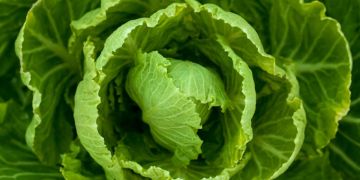In the process of cultivating cabbage, other Brassica varieties emerged, some of which include:
• Kale
• Broccoli
• Cauliflower
• Brussels Sprouts
• Collards
Cultivation
The cabbage plant has become highly adaptable to different climate zones, which accounts for the various shapes, leaf textures and colors found within the cabbage family. In terms of leaf types, the crinkled-leaf, loose-head savoys and the smooth leaf firm head cabbages make up the two main categories of cabbage plants. Today many countries, such as India, Russia, the United States and China grow cabbage crops in mass quantities, with China supplying nearly 50 percent of the world’s cabbage supply.
Nutritional Value
Cabbage’s nutritional value lies mostly in the leaves of the plant. As far as nutritional content goes, some of the nutrients found in cabbage include:
• Calcium
• Iron
• Phosphorous
• Sulfur
• Silica
The active ingredients found in cabbage are responsible for promoting overall health and healing for the body. Amino acids, such as S-methyl cysteine, and anthocyans strengthen the body’s cell metabolism functions, which helps in eliminating cell wastes and promotes healthy body tissues. Mustard oil ingredients also work to flush free radical materials from cell bodies.
Health Benefits
Anti-inflammatory and anti-bacterial properties
The health benefits found in cabbage work to enhance the body’s ability to ward off sickness and prevent disease. Because of its nutrient content, cabbage has anti-inflammatoryand anti-bacterial properties. The anti-inflammatory properties help in the treatment of digestive problems, such as gastritis, heartburn and peptic ulcers. Cabbage’s anti-bacterial properties work inside the body’s cell processes and aid in detoxifying the body’s major systems. These same properties help to boost the immune system, which increases the body’s resistance to invading bacteria and viruses.
Amino acids
The active amino acid ingredients found in cabbage have also shown to promote the production of carcinogen-fighting enzymes. Carcinogen-fighting enzymes prevent free radical materials from damaging cell structures. Damaged cell structures are the most vulnerable to free radical waste materials, which act as food for potentially cancerous cells.
High in fiber
With a high fiber content, cabbage plays an active role in ridding the body of LDL cholesterols or bad cholesterols. These properties also help to stimulate digestive processes and relieve constipation problems. The high iron and chlorophyll content found in cabbage also helps in the treatment of depression, insomnia, exhaustion and anxiety.
How To Take
Raw, uncooked cabbage provides the highest nutritional value overall as well as a high fiber content. Herbal supplements are also derived from the raw, uncooked plant. When measuring nutritional value in terms of weight amounts, 100 grams (3.5 ounces) of raw cabbage includes the following FDA-recommended daily allowances:
• Vitamin C – 44 percent
• Vitamin K – 72 percent
• Vitamin B6 – 10 percent
• Vitamin B9 – 13 percent
• Vitamin B1 – 5 percent
As an herbal supplement, cabbage carries the same fortifying ingredients in capsule and tablet forms as well as prepared in juice, soups and teas. In tablet or capsule form, the standard dosage is 500 milligrams which contains the daily recommended amounts for each nutrient. In juice forms, cabbage acts as an intestinal cleaner and detoxifier.
Since any form of cooking alters the chemical properties of an herbal preparation, cabbage used in soups and teas will best treat certain conditions more so than others. In soups and teas, the effects of cabbage are most effective at relieving symptoms associated with sinusitis, sore throats, colds and flu.
Cabbage supplements can be taken as a tincture or in tablet/capsule form. Daily standard dosages for the different preparations are:
• Tinctures – 5 drops
• Tablets/ capsules – 500 milligrams
• Globules – 10 per hour





